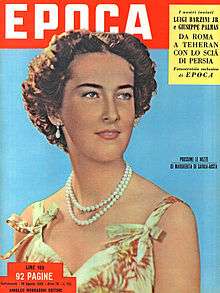Epoca (magazine)
Epoca (meaning Age in English) was an Italian illustrated weekly current events magazine published in Milan, Italy.
 1953 cover featuring Margherita, Archduchess of Austria-Este | |
| Former editors | Alberto Mondadori Enzo Biagi |
|---|---|
| Categories | Current affairs magazine |
| Frequency | Weekly |
| Year founded | 1950 |
| First issue | 14 October 1950 |
| Final issue | 1997 |
| Company | Mondadori Rizzoli Editori |
| Country | Italy |
| Based in | Milan |
| Language | Italian |
| ISSN | 0013-9718 |
| OCLC | 1718813 |
History and profile

Epoca was first published on 14 October 1950.[1][2][3] The magazine was modelled on Life[4][5] and Paris Match.[2] The magazine was part of Mondadori[3][6] and was based in Milan.[7]
Its first editor was Alberto Mondadori who was succeeded in the post by Enzo Biagi in 1953.[2] The magazine sold 500,000 copies in 1955.[2]
During the period until 1960 when Enzo Biagi edited Epoca the magazine covered current affairs news, social attitudes as well as TV news.[2] The magazine also included frequent and detailed articles about Hollywood stars of the period[8][9] and Italian movie stars such as Gina Lollobrigida.[10] The weekly had offices in New York, Paris and Tokyo.[5] From June 1952 to the late 1958 the Cuban-Italian writer Alba de Céspedes wrote an agony column, called Dalla parte di lei, in the magazine.[11]
Then Epoca became part of Rizzoli Editori[5] and began to cover travel and nature news with photographs and scientific articles.[2] The magazine had a section called I bei posti (meaning Beautiful Places in English) where the photographs of unknown places such as Bahamas, Marrakesh and Acapulco by Mario de Biasi, Alfredo Panucci and Giorgio Lotti were published.[4]
Epoca's circulation was 400,000 copies in 1963.[12] In 1970 the circulation of the magazine was 350,000 copies.[13] The weekly had a circulation of 120,046 copies in 1984.[14]
Epoca was closed down in 1997 due to low circulation.[2][7]
See also
References
- "1940s/1950s/Early 1960s Italian People's Magazines". Listal. Retrieved 5 December 2014.
- Gino Moliterno (11 September 2002). Encyclopedia of Contemporary Italian Culture. Routledge. p. 289. ISBN 978-1-134-75876-0. Retrieved 6 December 2014.
- "Magazines". Mondadori. 14 February 2012. Retrieved 5 December 2014.
- Angela Vettese (2012). "Italy in the Sixties: A Historical Glance" (PDF). In Bernhard Mendes Bürgi (ed.). Arte Povera. The Great Awakening. Hatje Cantz. ISBN 978-3-7757-3357-1. Retrieved 19 April 2015.
- Gabriella Ciampi de Claricini (February 1965). "Topical weeklies in Italy". International Communication Gazette. 11 (1): 12–26. Retrieved 25 April 2015.
- "Time Inc in Joint Venture to Publish Italian Fortune". Associated Press. 7 November 1988. Retrieved 17 February 2015.
- "Epoca". Behance. Retrieved 5 December 2014.
- Stephen Gundle (4 December 2000). Between Hollywood and Moscow: The Italian Communists and the Challenge of Mass Culture, 1943–1991. Duke University Press. p. 47. ISBN 0-8223-2563-2. Retrieved 19 April 2015.
- Stephen Gundle (Summer 2002). "Hollywood Glamour and Mass Consumption in Postwar Italy" (PDF). Journal of Cold War Studies. 4 (3). Retrieved 27 April 2015.
- Réka C. V. Buckley (2000). "National Body: Gina Lollobrigida and the cult of the star in the 1950s". Historical Journal of Film, Radio and Television. 20 (4): 527–547. doi:10.1080/713669741.
- Penny Morris (2004). "From private to public: Alba de Céspedes' agony column in 1950s Italy". Modern Italy. 9 (1): 11–20. doi:10.1080/13532940410001677467.
- Randolp S. Churchill (17 January 1964). "The Press". The Spectator. Retrieved 19 April 2015.
- "The Press: Women, Not Girls". Time. 18 January 1971. Retrieved 17 February 2015.
- Maria Teresa Crisci. "Relationships between numbers of readers per copy and the characteristics of magazines" (PDF). The Print and Digital Research Forum. Retrieved 14 April 2015.
| Wikimedia Commons has media related to Epoca (magazine). |